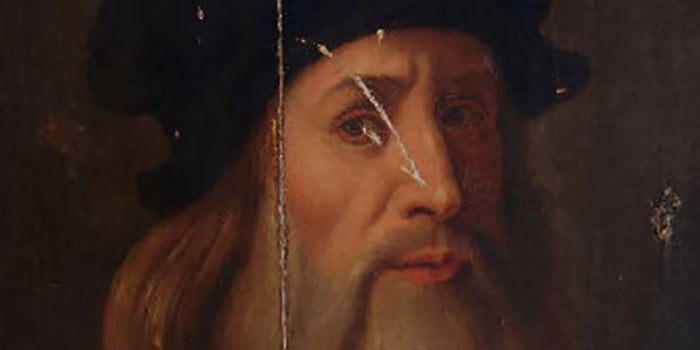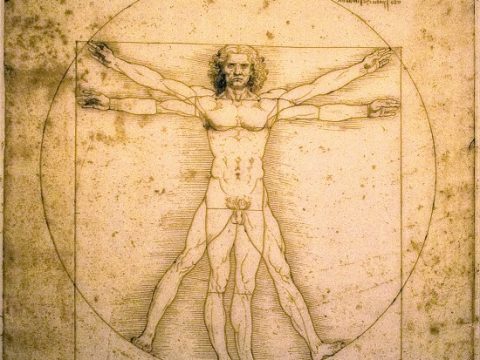Leonardo Da Vinci
About Leonardo da Vinci: It was on April 15, 1452, that Leonardo was born in the town of Vinci, Republic of Florence, in what is now in Italy, the illegi.

Synopsis During the Italian High Renaissance, the spirit of Humanism abounded, in which artists were deeply entrenched in a study of the humanities to consistently better themselves as people of the world. A person immersed in the comprehension and accomplishment of such varied interests would become later termed a 'Renaissance man.' Leonardo da Vinci was the first prime exemplar of this term. Although his exhaustive personal interests led to his mastery of multiple fields, he is widely considered one of the greatest painters of all time. His iconic works continue to be studied and revered today.
Leonardo Da Vinci Paintings
Working at full capacity with both left and right sides of his brain, Leonardo's unquenchable curiosity and inventive imagination produced many contributions to society that were ahead of his time. He is credited with making the first drawings that preordained the parachute, helicopter, and military tank. His notebooks are nearly as esteemed as his artworks. Within, they represent a culmination of his life's work and his genius mind, containing drawings, scientific diagrams, and his philosophies on painting. They continue to be studied today by artists, scholars, and scientists worldwide.
- Born Leonardo di ser Piero da Vinci but more commonly known as Leonardo da Vinci, the Italian artist was a supremely talented individual. As well as a skilled painter he was also, among other things, a sculptor, architect, musician, scientist, inventor and writer.
- In the “luminous” (Daily Beast) Leonardo da Vinci, Isaacson describes how Leonardo’s delight at combining diverse passions remains the ultimate recipe for creativity. So, too, does his ease at being a bit of a misfit: illegitimate, gay, vegetarian, left-handed, easily distracted, and at times heretical.
Leonardo da Vinci was a true genius who graced this world with his presence from April 15, 1452 to May 2, 1519. He is among the most influential artists in history, having left a significant legacy not only in the realm of art but in science as well, each discipline informing his mastery of the other. Da Vinci lived in a golden age of creativity among such contemporaries as Raphael and Michaelangelo, and contributed his unique genius to virtually everything he touched. Like Athens in the age of Pericles, Renaissance Italy is a summit in human history. Today, no name better seems to symbolize Renaissance age than Leonardo da Vinci. Early Years: 1452 to 1476 Leonardo da Vinci was born in a Tuscan hamlet near Vinci. He began a nine-year apprenticeship at the age of 14 to Andrea del Verrocchio, a popular sculptor, painter and goldsmith who was an important figure in the art world of the day.
At Verrocchio's busy Florence studio, the young Leonardo likely met such masters as while working beside fellow apprentices Domenico Ghirlandaio, Pietro Perugino and Lorenzo di Credi. Verrocchio, who had learned his craft under the master, was the officially recognized sculptor for the Medici family, the rulers of Italy during this era. Under Verrocchio's tutelage, da Vinci probably progressed from doing various menial tasks around the studio to mixing paints and preparing surfaces. He would have then graduated to the study and copying of his master's works.
Finally, he would have assisted Verrocchio, along with other apprentices, in producing the master's artworks. Da Vinci not only developed his skill in drawing, painting and sculpting during his apprenticeship, but through others working in and around the studio, he picked up knowledge in such diverse fields as mechanics, carpentry, metallurgy, architectural drafting and chemistry. In 1473, when he was more than halfway through his studies with Verrocchio, he completed, a pen and ink depiction of the Arno River valley. It is the earliest work that is clearly attributable to da Vinci. Leonardo da Vinci's drawings would become an essential part of his legacy.
Da Vinci sketched prolifically, planning inventions, exploring human anatomy, drawing landscapes, and blocking out plans for paintings such as and his sole surviving mural,. Simplicity is the ultimate sophistication.” - By Leonardo da Vinci Much of his other creative output during his time with Verrocchio was credited to the master of the studio although the paintings were collaborative efforts.
Over the years, historians have closely examined such Verrocchio masterpieces as and to weigh in on which specific figures da Vinci was responsible for. In the 'Baptism of Christ,' which dates to 1475, experts speculate that one of the angels is da Vinci's own work, while in 'The Annunciation,' produced within the same time period, experts detect the work of the apprentice artist's brush in the angel's wings and the background. In fact, historians x-rayed 'The Annunciation' to definitively distinguish between Verrocchio's heavier brush strokes with lead-based paint from da Vinci's lighter, water-based paint strokes. Although a member of the Florence painters' guild as of 1472, the artist continued his studies with Verrocchio as an assistant until 1476. The influences of his master are evident in the remarkable vitality and anatomical correctness of the Leonardo paintings and drawings. Middle Years: 1477-1499. After leaving the Verrocchio studio to set up his own, da Vinci began laying the groundwork for his artistic legacy.
Like his contemporaries, he focused on religious subjects, but he also took portrait commissions as they came up. Over the next five years or so, he produced several notable paintings, including,. The latter two pieces are unfinished. Leonardo da Vinci received a commission to paint his 'Adoration of the Magi' from Florence church elders who planned to use it as an altarpiece.

This artwork is historically significant by virtue of the innovations da Vinci made that were unique among the art conventions of the 1480s. He centered the Virgin and Christ child in the scene whereas previous artists had placed them to one side. Da Vinci improved on standard practices of perspective by making changes in clarity and color as objects became increasingly distant. Unfortunately, he did not complete the commission due to a better offer from the Duke of Milan to become the resident artist at his court. While in Milan, the artist called upon his varied interests and knowledge to create stage sets and military designs for the Duke as well as paintings. Early in his tenure at court, da Vinci produced his first version of, a six-foot-tall altarpiece also called the 'Madonna of the Rocks.' In this painting, which dates to 1483, the artist experiments with blending the edges of objects in indistinct light to create a sort of smoky effect known as sfumato, a technique the artist would continue to develop in his future works.
It was perhaps because of his desire to fine-tune this technique that his other surviving painting from his years in Milan, deteriorated so quickly. The artist used oil-based paint on plaster for this scene of Jesus and his apostles at the table because his customary water-based fresco paints were difficult to blend for the sfumato effect he sought. Within only a few decades, much of the painting had flaked away from the wall in its location at the Santa Maria del Grazie convent.
The canvas of Leonardo da Vinci's 'Last Supper' that now hangs in the Louvre is, in large part, a reproduction of the failed fresco. Painting is poetry that is seen rather than felt, and poetry is painting that is felt rather than seen.” - By Leonardo da Vinci Later Years: 1500-1519 Upon the French invasion of Milan, the artist returned home, via Venice and Mantua, to Florence. His reputation preceded him, and he was lauded by old friends and up-and-coming artists captivated with his innovations in art. During this final era of his life, da Vinci completed a greater number of paintings than he had thus far.
When he resettled in Florence in 1500, the artist made preliminary progress on his painting,' which he would set aside unfinished, not to be completed for another 10 years. Leonardo began creating his most well-known and replicated work, a couple of years later when he received a commission from Francesco del Giocondo to paint his wife. The precise date of completion for 'Mona Lisa' is still in question, but many historians agree that da Vinci began the masterpiece in 1503.

Leonardo da Vinci also accepted a commission for a mural to be installed in the Hall of 500 at Palazzo Vecchio in Florence. The subject was a, and the painting depicted a tangle of muscular horses and warriors. It was, however, destined to be unfinished. Contemporary master received a commission to paint the on the opposite wall, also a work left unfinished. Nothing of da Vinci's battle scene survived, except for a copy by artist and Leonardo's own preliminary sketches.
In approximately the same period, the artist created his second version of the painting, 'Virgin of the Rocks,' which was likely a commission for installation in a chapel at Milan's church of San Francesco Maggiore. Chief differences between the two versions include color choices, lighting and details of composition.